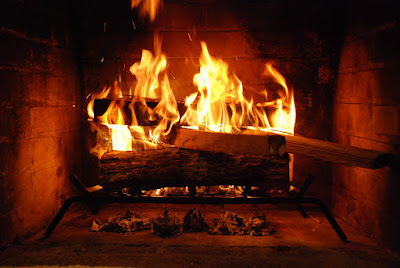"And, for the winter fireside meet,
Between the andirons' straddling feet,
The mug of cider simmered slow,
The apples sputtered in a row,
And, close at hand, the basket stood
With nuts from brown October's wood.
"What matter how the night behaved?
What matter how the north-wind raved?
Blow high, blow low, not all its snow
Could quench our hearth-fire's ruddy glow."
From John Greenleaf Whittier's "Snowbound"
The origin of fire and man's use of it is unknown. Was it the result of some individual noting that a remaining ember from a wildfire was still hot and that a piece of dry grass placed near it caught fire and burned? We may never know the origins, but it is believed that man discovered fire very early on. Many cave art drawings show man near a fire. What a comfort it must have been on a cold night to sit with hands stretched out and feet, too, pointed towards the warmth the fire produced.
Imagine man's delight in discovering that flint struck against flint would cause a spark that might be used to start a fire. Native Americans used this method. I was thrilled as a child when my grandfather showed me the quartz rocks called flint and showed me how they were used to strike one against the other and create a spark that could possibly be made into a fire.
Man's relationship with fire has had a long history. Fire was coveted for it's warming properties as well as it's ability to cook foods. At one point, fire was so precious that one had to guard it to keep it from being stolen. Firekeepers watched over the fires and protected them against thievery.
Many fires were communal ones and individual fires were made from that communal fire so that all members had warmth of their own to carry into their dwellings. What a sense of community that must have created.
Early man learned to transport embers buried deep in ash and carried that ember to the next camp where it was coaxed into flame once more with dry wood and grass. Eventually hot coals were carried in metal and clay pots with chimneys that allowed for air to keep the coals alive. These were called censers in Biblical days and incense was put on top of the hot coals. The fragrant smoke that resulted was meant to be pleasing to God.
Those fire pots eventually came to be called curfews and were placed over a family's fire embers each night at a set time. Bells rang throughout a city signaling the arrival of curfew and the fire was 'put to sleep' before the family went to bed. These curfews became royal orders and eventually laws and remained in effect for many hundreds of years.
The original hearths of many homes were built in the center of the house. It is believed that round houses were made originally because of this and smoke exited the house via a hole directly above the hearth. That likely is how the fireside became the heart (hearth) of the home. Here the family revolved about the fire. Cooking, eating, staying warm.
Eventually chimneys were built to draw the smoke away from the fire. This made the fireside much more pleasant. Up until that time, often enough, more smoke stayed within the dwelling than ever drifted out.
It was the chimney which led to the fireside we so often picture as the coziest of cozies in winter's cold days. We pull our chairs near and contemplate the flames as they dance. We sit mesmerized and dream or speak slowly and deeply and absorb the warmth. And if we're especially blessed, we find a good book to sit and enjoy, as well.
What better occupation, really, than to spend the evening at the fireside with a book, with the wind beating on the windows and the lamp burning bright...Gustave Flaubert
“Winter is the time for comfort, for good food and warmth, for the touch of a friendly hand and for a talk beside the fire: It is the time for home.” —Edith Sitwell, poet





1 comment:
Hi Terri - I enjoyed this discussion on fire! We heat our home with two woodstoves, one on our main level and one in our finished basement. It is a very cozy and radiant heat and we enjoy it in the winter months. But it is messy also - ashes, dust and bits of kindling and firewood scattered around which I clean up daily. But still worth the mess in my estimation. Blessings, Shirley
Post a Comment